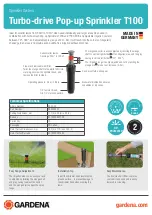
10
•Insert the Membrane up into the manifold.
(The O–rings should be up toward the
manifold.) Check the Housing O–ring for
proper position in its groove, engage and
firmly tighten the Housing hand tight only.
3. Rinsing the system:
•Slowly open the Feed Water Saddle Valve
fully counter clockwise.
•The Holding Tank Valve should be open.
•Check the Air Gap Window on the
Dispensing Faucet to be sure that the drain
water is flowing. (Refer to Figure 2, page 6.)
The R.O. System is now making water.
•Do not open the Faucet for at least 8 hours.
•Do not use the first three full tanks of water.
CAUTION:
The R.O. Membrane is shipped
with a preservative in it. To ensure proper
rinsing of the R.O. Membrane it is important
to wait at least 8 hours before emptying each
tank.
When the Faucet is first opened, expect air
and carbon fines (very fine black powder)
from the Activated Carbon Post Filter to be
rinsed out. This is normal for the first tank
of water or after the Activated Carbon Post
Filter is changed.
SECTION IV. OPERATION & MAINTENANCE
A. Normal Operation
1. It is normal for the Total Dissolved Solids
(TDS) of the water to be higher than normal
during the first 5 gallons of operation; this is
due to the sanitizing solution and the new
Post Filter. After this water is rinsed to drain,
the removal rate should stabilize at a value of
greater than 75%.
2. R.O. systems produce drinking water at
relatively slow rates; it can take up to 5 hours
or more to fill the Holding Tank. Normal
operation is to let the Holding Tank fill with
water and then draw water as needed. When
the pressure in the Holding Tank falls to a
given pressure (as the water is being used) the
Automatic Shutoff Valve (ASO Valve) will
start water production and the system will refill
the Holding Tank. When the Holding Tank is
full and no water is being used, the ASO Valve
will automatically shut–off the feed water to
conserve water.
The more water that is used (up to the capacity
of the system) the better the R.O. system will
function. Other uses for the water are flowers,
pets and rinsing glassware.
With each use it is recommended that you
turn the tap for at least 10 seconds prior to
using water. This is especially important if the
water tap has not been used daily. After periods
of non–use, such as a week of vacation, it is
better to empty the holding tank and allow the
system to produce fresh water for use. If the
system is not used for 3–4 weeks or longer, it
is a good idea to resanitize the system and to
change the Sediment/Carbon Prefilter and the
Activated Carbon Post Filter.
B. Changing Filters
THIS R.O. SYSTEM CONTAINS FILTERS
WHICH MUST BE REPLACED AT REGULAR
INTERVALS TO MAINTAIN PROPER
PERFORMANCE. USE ONLY FACTORY
APPROVED FILTERS.
All individuals should take adequate precautions
when changing the filters, including wearing
protective gloves, to avoid direct contact with the
exhausted filters.
The recommended interval for changing the
filters (not the R.O. Membrane) is every six (6)
months. Typical T.F.C. Membrane life expectancy
is three years. Local conditions may dictate more
frequent changes.
NOTE:
If the R.O. Membrane is to be replaced,
see Sec. III, F.1–3, page 9 for the proper procedure.
Use a drip pan to catch any water that may spill
when the Filter Housings are removed. Refer to
Fig. 1, page 3 for component location.
1. Close the Feed Water Saddle Valve by turning
fully clockwise and open the Dispensing Faucet
by lifting the handle. Allow the Holding Tank
to empty.
2. Loosen and remove the Sediment/Carbon
Filter and the Activated Carbon Filter
Housings. Discard the filters.
3. Wash the inside of the Housings using a mild
detergent and a soft cloth. Do not use abrasive
cleaners or pads. Thoroughly rinse all soap
from the Housings before reassembly.
4. To sanitize the system and replace the filters:
NOTE:
The system should be sanitized before
installing the Sediment/Carbon Prefilter and
Activated Carbon Post Filter.


































